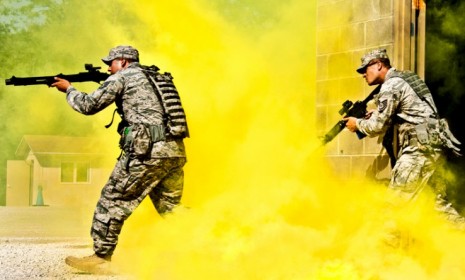Will MIT’s 'x-ray vision' help soldiers see through walls?
A complex new machine could help soldiers target unseen enemies — even if they're hiding in a concrete building

Though America's robotic drones may be prone to malware attacks, the U.S. military is still consistently at the forefront of cutting-edge technology. The latest? An experimental radar system developed at MIT that could help soldiers "see" enemies moving behind concrete walls, using something akin to "x-ray vision." For the "urban war fighter," such a machine has powerful implications, says MIT's Gregory Charvat, who helped lead the project. A guide to the technology and its possibilities:
How does it work?
Humans can only see light emitted at certain wavelengths. This new technology employs short S-band radar waves invisible to the human eye. They're "similar to a Wi-Fi signal," and can penetrate walls in small quantities, says Leslie Horne at PC Mag. Normally, "99 percent of radar waves bounce off concrete walls." But the MIT team's "amplifier device" pushes more of the radar waves through walls up to 8 inches thick, and a receiver picks up any movement on the other side. That movement is then illustrated as a bright spot on a screen.
The Week
Escape your echo chamber. Get the facts behind the news, plus analysis from multiple perspectives.

Sign up for The Week's Free Newsletters
From our morning news briefing to a weekly Good News Newsletter, get the best of The Week delivered directly to your inbox.
From our morning news briefing to a weekly Good News Newsletter, get the best of The Week delivered directly to your inbox.
What does this "x-ray vision" machine look like?
For now, it's an 8-foot-long "unassuming array of antennas" arranged into two rows and loaded onto a cart along with a small display screen, says Fox News.
So how would the military use it?
The technology, still in its testing phases, is "currently rather hefty," says Chris Matyszczyk at CNET. In the future, scientists "expect to see it mounted on a military vehicle" for field use. "Our objective is to aid the urban warfighter to assist his situational awareness," says Charvat. "If you're in a high-risk combat situation... you don't want to have to stand right next to a potentially dangerous building."
A free daily email with the biggest news stories of the day – and the best features from TheWeek.com
-
 The week’s best photos
The week’s best photosIn Pictures A drive in the desert, prayers with pigeons, and more
-
 The Week Unwrapped: Will drought fuel global violence?
The Week Unwrapped: Will drought fuel global violence?Podcast Plus why did Trump pardon a drug-trafficking president? And are romantic comedies in terminal decline?
-
 Sudoku hard: December 5, 2025
Sudoku hard: December 5, 2025The daily hard sudoku puzzle from The Week